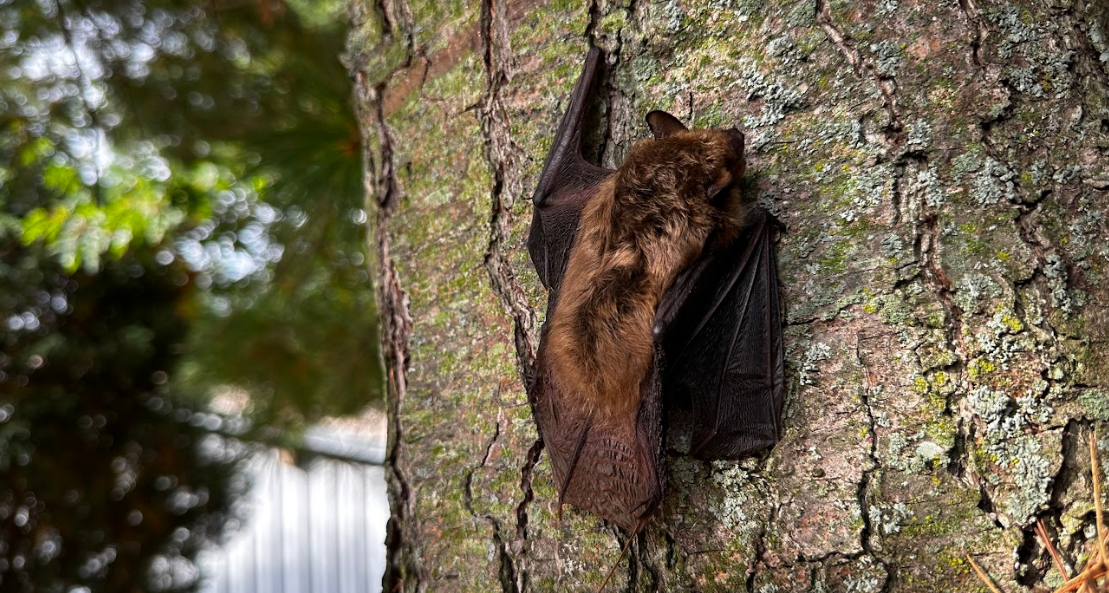BAT REMOVAL PROCESS
Assess and Remove
The key to removing bats from your home is determining their entry points. Bats can enter through small openings and leave very little trace behind. Our expert technicians will identify all the entry points and evict the colony humanely using one-way doors that allow the bats to leave for food but prevent their re-entry.
Clear and Clean
Depending on the size of the colony and how long they’ve been living in the home there could be a large mess to clean up. Our wildlife technicians will thoroughly remove bat guano and disinfect the space to eliminate any harmful traces left behind.
Bats play a vital role in our ecosystem, contributing to natural pest control and pollination. However, when they invade residential and commercial properties, they can pose serious health risks and property damage. The presence of bats in your attic or walls can result in unsanitary conditions and structural issues due to their droppings. This is why the need for humane bat removal in Richmond Hill is essential. Our team understands the importance of addressing these issues effectively while respecting the well-being of the bats and the environment.
At Skedaddle, we take pride in our commitment to ethical practices. Our experts are trained to safely assess and remove bats from your property without resorting to harmful methods. We employ exclusion techniques that ensure bats are guided out of your space and prevented from returning, all while considering their natural behaviour and lifecycle. By choosing our humane bat removal services, you not only protect your home but also contribute to the conservation of bats. We believe that by providing a safe and comfortable environment for both humans and wildlife, we can coexist harmoniously. Let us help you reclaim your space while maintaining the integrity of our local wildlife.
Skedaddle Humane Wildlife Control provides specialized exclusion services aimed at permanently keeping wildlife out of your home. Our team conducts comprehensive inspections to identify potential entry points and employs effective strategies to seal them off. Using humane removal methods, we ensure that animals are safely removed and prevented from re-entering. With an emphasis on long-term solutions, we combine expertise in local wildlife behavior with top-notch craftsmanship, giving homeowners confidence that their spaces will remain free of unwanted visitors.
Problems Bats Cause For Home and Business Owners
Bats are nocturnal creatures known for their ability to navigate in the dark through echolocation. While they are beneficial for controlling insect populations and pollinating plants, their presence in residential or commercial spaces can lead to significant problems. When bats roost in attics or on building exteriors, their droppings, or guano, can accumulate, creating unsanitary conditions. This waste produces a strong, unpleasant odour and can attract pests, such as insects and rodents, further complicating the situation.
Additionally, bat droppings can carry health risks, including histoplasmosis, a respiratory illness caused by a fungus that thrives in cave and bird droppings. The excrement can also corrode building materials, leading to costly structural damage. For business owners, having bats in or around their properties can deter customers and tarnish their reputation, making it essential to address any bat issues promptly.
To prevent bats from entering your home or business, we recommend several measures. First, ensure that any gaps, holes, or cracks in your building’s exterior are sealed. Bats can enter through surprisingly small openings, so attention to detail is crucial. Installing bat houses nearby can also provide them with an alternative place to roost, allowing you to coexist peacefully with these animals.
In addition, we advise keeping outdoor lighting minimal, as bats are attracted to insects that congregate around lights. Regular property inspections can help to identify potential entry points early on. If you suspect a bat infestation, it’s essential to seek professional wildlife removal in Richmond Hill. Our team at Skedaddle is equipped to handle these situations humanely, ensuring that both your property and the local wildlife are cared for properly.
How To Get Rid Of Bats The Skedaddle Way
At Skedaddle, we are committed to a humane approach to bat removal, prioritizing the safety of both our clients and the bats themselves. Our process begins with an initial consultation, where our team conducts a thorough inspection of your property to identify any signs of bat activity. This assessment allows us to understand the extent of the issue and pinpoint the locations where bats are gaining entry. We believe that careful observation is critical in ensuring an effective removal strategy that respects the natural behaviours of these creatures.
Once we have gathered all the necessary information, we move to the next phase: exclusion. Instead of trapping or relocating bats, we implement exclusion methods that allow the animals to leave your property safely. We strategically install one-way exclusion devices at identified entry points. These devices are designed to enable bats to exit but prevent their return, giving them a chance to find a new roosting site without harm. The timing of this step is essential, as we ensure that we perform the exclusion during optimal seasons to avoid any disruptions to the bats’ mating or migration patterns.
After the bats have exited, we perform a comprehensive clean-up to address any mess left behind. This includes safely removing droppings and any nesting materials, which are essential for preventing health risks associated with bat guano. Following this, we seal up the entry points to ensure bats and other wildlife cannot re-enter your space. Finally, we provide recommendations for maintaining your property in a bat-friendly manner that minimizes the risk of future infestations. Throughout the process, our goal is to create a balance between effective removal and the conservation of local bat populations, allowing us to coexist harmoniously in our environment.
Life in Richmond Hill
Living in Richmond Hill offers a unique blend of suburban comfort and urban convenience, making it an attractive place for families and professionals. Known for its beautiful parks, excellent educational institutions, and diverse community, this city has much to offer its residents. One popular location is the Richmond Green Sports Centre and Park, which features sports fields, tennis courts, and walking trails, providing ample opportunities for outdoor activities and recreation.
The city was originally inhabited by Indigenous peoples before European settlers arrived in the early 19th century. As the region developed, it became known for its agriculture, particularly the cultivation of peaches, which earned it the nickname “The City of the Canadian Peach.” Today, remnants of this agricultural heritage can be experienced at local markets that feature fresh produce and artisanal goods.
Residents enjoy a vibrant calendar of events throughout the year, including the Winter Carnival and the annual Canada Day celebrations, which foster a strong sense of community involvement. In addition to these festivities, the city’s diverse population contributes to a variety of cultural restaurants and shops that reflect the global influences of its residents.
We at Skedaddle appreciate that living in this city means not only enjoying beautiful surroundings but also benefiting from a strong sense of community and connection. The people here take pride in their neighbourhoods and actively participate in preserving the environment, which aligns with our values of humanely coexisting with local wildlife. By promoting awareness and responsible practices, we aim to support the natural beauty that Richmond Hill is known for.
Give Our Team A Call Today For Humane Wildlife Control in Richmond Hill
Managing bat populations humanely is crucial for both the health of our community and the well-being of local wildlife. At Skedaddle, we believe in creating solutions that protect your property while also respecting the natural behaviours of bats. Our thorough inspection and exclusion methods ensure that bats can safely relocate without harm, allowing for peaceful coexistence between humans and these misunderstood creatures. We understand the challenges that come with bats making their home in or around your property, and we are here to provide support every step of the way.
If you are dealing with a bat issue or simply want to take proactive measures to prevent one, we encourage you to reach out to our expert team at Skedaddle. Our dedicated professionals are equipped with the knowledge and skills to help you maintain a safe and welcoming environment. Don’t wait until a small problem becomes a big one—give us a call today and let us assist you in achieving a harmonious balance with the wildlife in Richmond Hill. Together, we can ensure that both your home and the local bat populations thrive.

Bat Facts
FACT:
Bats are the only flying mammals, capable of true flight. Unlike birds, which have feathers, bats have wings made of skin stretched between their elongated fingers, allowing them to manoeuvre with impressive agility and speed in the air.
FACT:
A single bat can consume thousands of insects in just one night. This foraging behaviour helps control pest populations, making bats essential for agriculture and natural ecosystems, where they play a crucial role in maintaining balance among insect species.
FACT:
Bats use echolocation to navigate and hunt for food. They emit high-frequency sounds that bounce off objects, allowing them to determine the location, size, and shape of surrounding objects, enabling them to effectively avoid obstacles and catch prey.
FACT:
There are over 1,400 species of bats worldwide, making them one of the most diverse groups of mammals. They inhabit various environments, from tropical rainforests to deserts, showcasing their adaptability and importance in different ecosystems around the globe.
FACT:
Many bat species are social creatures, often roosting in large colonies that can number in the thousands. These colonies provide protection against predators and allow social interaction, which can enhance their survival chances and promote species cooperation during foraging.
CHECK OUT OUR LATEST BLOGS
Richmond Hill Wildlife Control: Unveiling the Mysteries of Bat Echolocation
Richmond Hill Wildlife Control: What Is a Big Brown Bat?
Richmond Hill Wildlife Removal: Are Bats Related to Birds?











